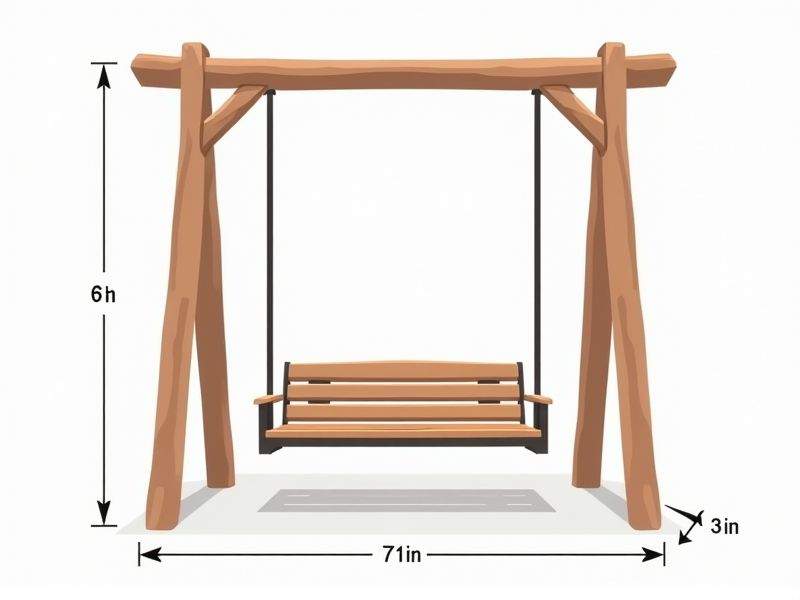
When selecting a porch swing, it's helpful to know the typical dimensions to ensure a comfortable fit on your porch. Standard porch swings usually measure about 4 to 5 feet in length, which comfortably seats two to three people. The seat depth often ranges from 18 to 22 inches, providing ample support for most adults. To ensure proper installation and swinging motion, remember to allow at least 26 to 36 inches of clearance behind the swing and 14 to 16 inches on each side.
Seat Depth
The ideal seat depth for a porch swing typically ranges between 18 to 24 inches, ensuring comfort for users of various heights. A deeper seat, particularly around 22 to 24 inches, provides ample room for lounging, while a shallower option, close to 18 inches, can promote a more upright posture. Consider the angle of the backrest, which should complement the seat depth to enhance support and relaxation. Your choice of depth can significantly affect how much you enjoy swinging on your porch.
Seat Width
The standard seat width for a porch swing typically ranges from 48 to 60 inches, providing ample space for comfort and relaxation. When selecting a swing, ensure the width accommodates the desired number of users--two people can comfortably sit on a 48-inch swing, while a 60-inch model is suitable for three. Consider the overall design and construction materials, as high-quality wood or metal can enhance durability and aesthetic appeal. Your choice will not only impact the swing's functionality but also the visual harmony of your outdoor space.
Backrest Height
The ideal backrest height for a porch swing typically ranges from 20 to 30 inches, offering adequate support for your back and neck. When choosing a porch swing, ensure that the backrest is designed to accommodate your height for optimum comfort, especially if you spend extended time relaxing on it. A higher backrest provides additional comfort, particularly for taller individuals, while a lower one may be more suitable for a traditional aesthetic. Consider the material and design of the backrest as well, as these factors influence both the visual appeal and your overall relaxation experience.
Armrest Width
When selecting a porch swing, the armrest width plays a crucial role in comfort and usability. Typically, a standard armrest width ranges from 4 to 6 inches, providing ample space for resting your arms while enhancing the overall seating experience. A wider armrest can support various activities, such as holding a drink or a book, contributing to your relaxation. Prioritizing the right armrest width ensures you enjoy your porch swing to its fullest potential.
Chain Length
The ideal chain length for a porch swing typically ranges from 6 to 10 feet, providing adequate space for comfortable swinging while ensuring safety. A shorter chain may restrict movement, while a longer chain can lead to excessive sway and instability. It's essential to use heavy-duty chains, rated for at least 300 pounds, to support the weight of the swing and its occupants effectively. When installing, ensure the chains are securely attached to both the swing and the overhead structure, promoting a safe and enjoyable outdoor experience.
Weight Capacity
A standard porch swing typically accommodates a weight capacity ranging from 400 to 600 pounds, making it suitable for multiple users or individuals of varying sizes. When choosing a porch swing, it's essential to consider the materials used in its construction, such as durable wood or robust metal, as these significantly impact strength and longevity. Ensure that the swing's hanging hardware, including chains or ropes, is rated for your specific weight requirements to enhance safety. Opting for a swing with a higher weight capacity can provide extra peace of mind for you and your guests, allowing for a more enjoyable outdoor experience.
Overall Height
The overall height of a porch swing typically ranges from 18 to 24 inches from the ground to the seat. This measurement is crucial for ensuring comfort and ease of access, allowing users to sit down and stand up without difficulty. Many designs also incorporate a backrest height between 20 and 30 inches, providing adequate support. When selecting a porch swing, consider your specific height preferences and how they fit with your outdoor space.
Material Thickness
Material thickness is a crucial standard in the durability and comfort of porch swings, typically ranging from 1-inch to 2-inch for wooden constructions. Swing frames should ideally feature at least 5/8-inch thick metal for enhanced stability and longevity. For optimal seating comfort, avoid swings with less than 1-inch thick seating slats, ensuring they can hold weights up to 500 pounds. Investing in well-crafted swings with appropriate material thickness can significantly improve your outdoor relaxation experience.
Swing Clearance
A porch swing should ideally have a swing clearance of at least 30 inches from the ground to ensure safe and comfortable use. This measurement allows for adequate space for legs to extend freely while seated. When installing, consider a minimum of 6 feet of clearance above to prevent any obstruction, allowing for smooth swinging motion. Proper installation also includes securely attaching the swing to high-quality, weather-resistant hardware that supports a weight capacity of at least 600 pounds to accommodate multiple users.
Mounting Hardware Dimensions
When selecting a porch swing, the mounting hardware dimensions are crucial for ensuring stability and safety. Most porch swings require a minimum of 2 to 3 inches of space on either side for proper installation and weight distribution. For optimal support, use heavy-duty eye bolts with a minimum diameter of 5/16 inches, designed to handle loads of 500 pounds or more. Ensuring precise measurements will not only enhance your swing's functionality but also your overall outdoor experience.
